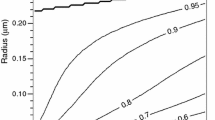Abstract
MieLab software was used to perform calculations of the scattering of electromagnetic radiation by single or multilayered spheres. The scattering efficiency results allowed the calculation of scattering coefficients SMie, which were then used to compare the scattering performance of different materials and composites. Furthermore, the simulation results were compared to experimental results obtained from testing real paint films using the Kubelka–Munk treatment for TiO2-only systems (SCoat). It was found that SMie follows the same profile as SCoat in response to the change in pigment volume concentration. The MieLab simulations were also applied to two composite configurations, hollow sphere nanoparticles or mesoporous silica nanoparticles attached to a TiO2 pigmentary size particle. The results showed that neither of these configurations is a viable solution for increasing scattering efficiency of TiO2 in the range of typical PVCs.



















Similar content being viewed by others
References
Bond, WL, “Measurement of the refractive indices of several crystals.” J. Appl. Phys., 36 1674–1677 (1965)
Johnson, R, Thiele, E, French, R, “Light-scattering efficiency of white pigments: an analysis of model core-shell pigments vs. optimized rutile TiO2.” TAPPI Journal., 80 (11) 233 (1997)
Auger, JC, Martinez, VA, Stout, B, “Theoretical study of the scattering efficiency of rutile titanium dioxide as a function of their spatial dispersion.” J. Coat. Technol. Res., 6 (1) 89 (2009)
Pena-Rodriguez, O, Gonzales Perez, PP, Pal, U, “MieLab a software tool to perform calculations on the scattering of electromagnetic waves by multilayered spheres.” Intl. J. Spectrosc., https://doi.org/10.1155/2011/583743 (2011)
Yang, W, “Improved recursive algorithm for light scattering by a multilayered sphere.” Appl. Opt., 42 (9) 1710 (2003)
Diebold, M, Application of light scattering to coatings. Springer, 2014
Zhang, L, Wang, H, Zhang, Z, Qin, F, Liu, W, Song, Z, “Preparation of monodisperse polystyrene/silica core-shell nano-composite abrasive with controllable size and its chemical mechanical polishing performance on copper.” Appl. Surf. Sci., 258 1217 (2011)
Lasio, J, Allgeier, AM, Chan, CD, Londono, JD, Najafi, E, Woerner, FJ, “Control of mechanical stability of hollow silica particles, and its measurement by mercury intrusion porosimetry.” Langmuir, 33 (19) 4666–4674 (2017)
Stober, W, Fink, A, Bohn, E, “Controlled growth of monodisperse silica spheres in the micron size range.” J. Colloid and Interf. Sci., 26 62 (1968)
Fang, X, Chen, C, Liu, Z, Liu, P, Zheng, N, “A cationic surfactant assisted selective etching strategy to hollow mesoporous silica spheres.” Nanoscale, 3 1632–1639 (2011)
Thiele, ES, “Scattering of electromagnetic radiation by complex microstructures in the resonant regime.” PhD dissertation, University of Pennsylvania (1998)
Bohling, JC, Hook, JW, Keefe, MH, Kravchenko, AV, Moretti, JJ, Varner, JN, “Stable aqueous composite compositions.” US Patent 8,710,133 B2, Apr 29, 2014
Kershaw, RW, “A new class of pigments.” Australian OCCA Proc. and News, 8 (4) 71 (1971)
Ross, WD, “Theoretical light scattering power of TiO2 and microvoids.” Ind. Eng. Chem. Prod Res Develop., 13 (1) 45 (1971)
Ross, WD, “Kubelka-Munk formulas adapted for better computation.” J. Paint Technol., 39 (511) 515–521 (1967)
Fasano, D, “Advancement in TiO2 composite technology.” www.picmag.com, 28, Aug 2012
Author information
Authors and Affiliations
Corresponding author
Additional information
Publisher's Note
Springer Nature remains neutral with regard to jurisdictional claims in published maps and institutional affiliations.
Appendix
Appendix
Ingredient | Active Ingredient | Wt (lbs) | Vol (gal) | |
|---|---|---|---|---|
Part 1 | ||||
Mix at low speed for 5 minutes (~ 500 RPM): | ||||
Water | 50 | 6.02 | ||
pH Control Agent | 1 | 0.13 | ||
In-can Preservative | 1.5 | 0.12 | ||
Dispersant | 25% | 9 | 1.00 | |
Cosolvent 1 | 30 | 3.48 | ||
Cosolvent 2 | 20 | 2.16 | ||
Coalescent | 17 | 2.15 | ||
Nonionic Surfactant | 1 | 0.12 | ||
Anti-foaming Agent | 1 | 0.13 | ||
Add and run at high speed 15 minutes (2500 RPM): | ||||
TiO2 | 100% | 255 | 7.65 | |
Subtotal Grind | 385.5 | 22.96 | ||
Water add | 117 | 14.08 | ||
Subtotal Mill base | 502.5 | 37.04 | ||
Part 2 | ||||
High Speed Mix for 10 minutes (2000 RPM): | ||||
Silicone Defoamer | 1.0 | 0.13 | ||
Cellulosic Thickener | 4.3 | 0.37 | ||
Water | 125.0 | 15.04 | ||
Subtotal Thickener solution | 130.3 | 15.5 | ||
Part 3 | ||||
Water Wash | 0 | 0.00 | ||
Anionic Surfactant | 30% | 3 | 0.43 | |
Water | 0 | 0.00 | ||
Binder Emulsion | 49.10% | 355 | 40.07 | |
Foam Control Agent | 4 | 0.55 | ||
Subtotal Resin Reduction | 362 | 41.05 | ||
Part 4 | ||||
Adjustment Water | 53 | 6.38 | ||
Total | 1047.8 | 100.0 | ||
PVC | 28.78 | |||
TiO2 lbs./gallon | 2.55 | |||
Paint Density lbs./gallon | 10.48 | |||
Wt solids | 41.59 | |||
Vol Solids | 26.81 | |||
Rights and permissions
About this article
Cite this article
Kraiter, D.C., Diebold, M.P. & Lasio, J. Use of MieLab software in scattering calculations. J Coat Technol Res 19, 1817–1836 (2022). https://doi.org/10.1007/s11998-022-00654-6
Received:
Revised:
Accepted:
Published:
Issue Date:
DOI: https://doi.org/10.1007/s11998-022-00654-6



